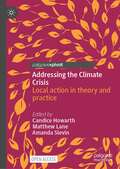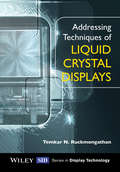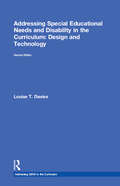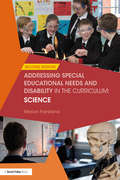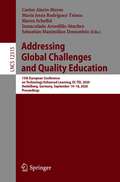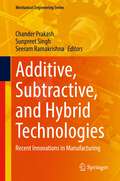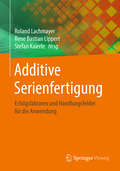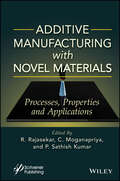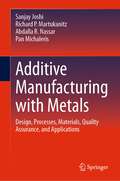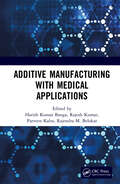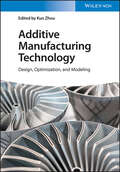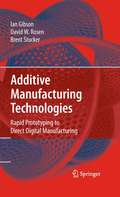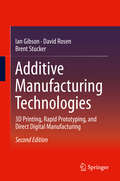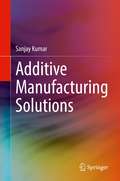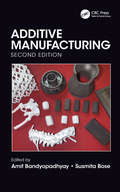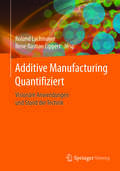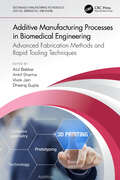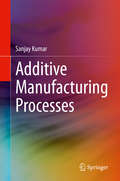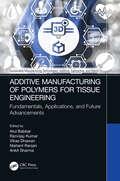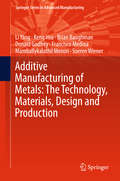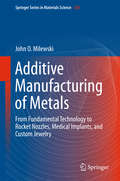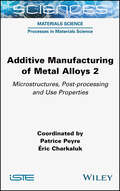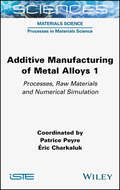- Table View
- List View
Addressing the Climate Crisis: Local action in theory and practice
by Candice Howarth Matthew Lane Amanda SlevinThis open access book brings together a collection of cutting-edge insights into how action can and is already being taken against climate change at multiple levels of our societies, amidst growing calls for transformative and inclusive climate action. In an era of increasing recognition regarding climate and ecological breakdown, this book offers hope, inspiration and analyses for multi-level climate action, spanning varied communities, places, spaces, agents and disciplines, demonstrating how the energy and dynamism of local scales are a powerful resource in turning the tide. Interconnected yet conceptually distinct, the book’s three sections span multiple levels of analysis, interrogating diverse perspectives and practices inherent to the vivid tapestry of climate action emerging locally, nationally and internationally. Delivered in collaboration with the UK’s ‘Place-Based Climate Action Network’, chapters are drawn from a wide range of authors with varying backgrounds spread across academia, policy and practice.
Addressing Techniques of Liquid Crystal Displays
by Temkar N. RuckmongathanUnique reference source that can be used from the beginning to end of a design project to aid choosing an appropriate LCD addressing technique for a given application This book will be aimed at design engineers who are likely to embed LCD drivers and controllers in many systems including systems on chip. Such designers face the challenge of making the right choice of an addressing technique that will serve them with best performance at minimal cost and complexity. Readers will be able to learn about various methods available for driving matrix LCDs and the comparisons at the end of each chapter will aid readers to make an informed design choice. The book will address the various driving techniques related to LCDs. Due to the non-linear response of the liquid crystal to external voltages, different driving methods such as passive and active matrix driving can be utilized. The associated theoretical basis of these driving techniques is introduced, and this theoretical analysis is supplemented by information on the implementation of drivers and controllers to link the theory to practice. Written by an experienced research scientist with over 30 years in R&D in this field. Acts as an exhaustive review and comparison of techniques developed for passive-matrix addressing of twisted nematic and super-twisted nematic (STN) LCDs. Discusses the trend towards "High Definition" displays and that a hybrid approach to drive matrix LCDs (combination of active and passive matrix addressing) will be the future of LCD addressing. Contains the author's recent work on Bit-Slice Addressing that is useful for fast responding LCDs, as well as a chapter on driving ferroelectric LCDs Provides an objective comparison that will enable designers to make an informed choice of an addressing technique for a specific application. Includes examples of the practical applications of addressing techniques. Organised in a way that each chapter can be read independently; with the basic knowledge and historical background gained from the introductory chapters, adequate for understanding the techniques that are presented in the remaining chapters making it a self-contained reference.
Addressing Special Educational Needs and Disability in the Curriculum: Design And Technology (Addressing SEND in the Curriculum)
by Louise T. DaviesThe SEND Code of Practice (2015) reinforced the requirement that all teachers must meet the needs of all learners. This topical book provides practical, tried-and-tested strategies and resources that will support teachers in making design and technology lessons accessible and interesting for all pupils, including those with special educational needs. The author draws on a wealth of experience to share her understanding of special educational needs and disabilities and show how the design and technology teacher can reduce or remove any barriers to learning. Offering strategies that are specific to the context of design and technology teaching, this book will enable teachers to: better identify a student’s particular learning requirements; set inclusive design and making assignments which allow all students to participate and succeed; build students’ confidence in using a range of materials and tools; assist with design tasks where pupils take ownership of their work and learning; adapt the classroom environment to meet the needs of pupils; create a mutually supportive classroom which maximises learning opportunities. An invaluable tool for continuing professional development, this text will be essential for design and technology teachers (and their teaching assistants) seeking to include and motivate all pupils in their lessons, regardless of their individual needs. This book will also be of interest to secondary SENCOs, senior management teams and ITT providers. In addition to free online resources, a range of appendices provide design and technology teachers with a variety of pro forma and activity sheets to support effective teaching. This is an essential tool for design and technology teachers and teaching assistants, and will help to deliver successful, inclusive lessons for all pupils.
Addressing Special Educational Needs and Disability in the Curriculum: Science (Addressing SEND in the Curriculum)
by Marion FranklandThe SEND Code of Practice (2015) reinforced the requirement that all teachers must meet the needs of all learners. This topical book provides practical, tried and tested strategies and resources that will support teachers in making science lessons accessible and exciting for all pupils, including those with special needs. The author draws on a wealth of experience to share her understanding of special educational needs and disabilities and show how science teachers can reduce or remove any barriers to learning. Offering strategies that are specific to the context of science teaching, this book will enable teachers to: help all students develop their ‘evidence-gathering’ skills and aid their scientific discovery by involving the use of all of the senses and structuring tasks appropriately; create a supportive environment that maximises learning opportunities; plan the classroom layout and display to enhance learning; use technology to adapt lessons to the needs of individual pupils; successfully train and fully use the support of their teaching assistants. An invaluable tool for continuing professional development, this text will be essential for teachers (and their teaching assistants) seeking guidance specific to teaching science to all pupils, regardless of their individual needs. This book will also be of interest to SENCOs, senior management teams and ITT providers. In addition to free online resources, a range of appendices provide science teachers with a variety of writing frames and activity sheets to support effective teaching. This is an essential tool for science teachers and teaching assistants, and will help to deliver successful, inclusive lessons for all pupils.
Addressing Global Challenges and Quality Education: 15th European Conference on Technology Enhanced Learning, EC-TEL 2020, Heidelberg, Germany, September 14–18, 2020, Proceedings (Lecture Notes in Computer Science #12315)
by Maren Scheffel María Jesús Rodríguez-Triana Carlos Alario-Hoyos Inmaculada Arnedillo-Sánchez Sebastian Maximilian DennerleinThis book constitutes the proceedings of the 15th European Conference on Technology Enhanced Learning, EC-TEL 2020, held in Heidelberg, Germany, in September 2020. The 24 research papers and 20 demo and 5 poster papers presented in this volume were carefully reviewed and selected from 91 submissions. The European Conference on Technology-Enhance Learning, which celebrates its 15th anniversary this year, is committed to address global challenges and quality education. The papers deal with the Sustainable Development Goals, particularly SDG 4 and SDG 10, to help to reduce the existing gaps and inequalities between countries and regions from around the world in terms of inclusiveness, equity, access, and quality of education.The chapters: “Designing an Online Self-Assessment for Informed Study Decisions: The User Perspective”; “Living with Learning Difficulties: Two Case Studies Exploring the Relationship Between Emotion and Performance in Students With Learning Difficulties”; “Applying Instructional Design Principles on Augmented Reality Cards for Computer Science Education”; and “Teaching Simulation Literacy With Evacuations - Concept, Technology, and Material for a Novel Approach” are available open access under a Creative Commons Attribution 4.0 International License via link.springer.com. Due to the Corona pandemic EC-TEL 2020 was held as an virtual event.
Addressing Emerging Trends to Support the Future of Criminal Justice: Findings of the Criminal Justice Technology Forecasting Group
by John S. Hollywood Dulani Woods Andrew Lauland Brian A. Jackson Richard SilberglittThe Criminal Justice Technology Forecasting Group (CJTFG) deliberated on the effects that major technology and social trends could have on criminal justice in the next two to five years and identified potential responses. This report captures the results of the group’s meetings and initiatives, presents the emerging trends and highlights of the group’s discussion, and presents the results of analyses to assess connections between the trends.
Additive, Subtractive, and Hybrid Technologies: Recent Innovations in Manufacturing (Mechanical Engineering Series)
by Seeram Ramakrishna Chander Prakash Sunpreet SinghThis book provides readers with the comprehensive insights of the recent research breakthroughs in additive, subtractive, and hybrid technologies. Further, the book examines incomparable design and manufacturing independences, as well as strategies to upgrade the product performance characteristics through collaborating additive and subtractive technologies. Indeed, the intrinsic benefits and limitations of both additive and subtractive manufacturing technologies could be merged to obtain appreciable hybridizations. The editorial team members and contributors to Additive, Subtractive, and Hybrid Technologies are highly motivated experts committed to and the advance of hybrid manufacturing technologies.
Additive Serienfertigung: Erfolgsfaktoren und Handlungsfelder für die Anwendung
by Roland Lachmayer Rene Bastian Lippert Stefan KaierleBei der additiven Fertigung wird anders als bei konventionellen Verfahren ein Bauteil nicht aus einem Block herausgefräst oder in einem Werkzeug gegossen, sondern es wird Schicht für Schicht generiert. Dieses Buch stellt eine Vielzahl verschiedener Aspekte der additiven Fertigung vor und erläutert anhand von Praxisbeispielen die Anwendungen und die Potenziale der Verfahren für eine Serienfertigung: Wo und wie kann die additive Fertigung erfolgreich eingesetzt werden?Die Autoren zeigen vor dem Hintergrund eines ganzheitlichen Entwicklungs- und Fertigungsprozesses mögliche Geschäftsmodelle auf, unter anderem die Fertigung in Microfactories. Leser erfahren, wie sich die Fertigungszeit und -kosten vorhersagen lassen, wie zuverlässig additiv gefertigte Strukturbauteile sind und inwieweit additive Fertigungsverfahren für die Herstellung von Endprodukten geeignet sind.Ferner diskutieren die Autoren, wie Pre- und Post-Prozesse genutzt werden können, um Serienanwendungen zu etablieren und diese iterativ zu verbessern. Neben den Möglichkeiten zur Qualitätssicherung bei der additiven Serienfertigung wird erläutert, wann es sinnvoll sein kann, konventionelle Fertigungsverfahren durch hybride Ansätze zu ergänzen. Die additive Instandsetzung als Alternative zum Entsorgen von verschlissenen Bauteilen wird ebenfalls erörtert. Im Hinblick auf eine Effizienzsteigerung diskutieren die Autoren Sicherheitsaspekte und legen Lösungsansätze bei Problemen im Umgang mit der additiven Serienfertigung dar.
Additive Manufacturing with Novel Materials: Process, Properties and Applications
by R. Rajasekar C. Moganapriya P. Sathish KumarADDITIVE MANUFACTURING With NOVEL MATERIALS The book explores practically the latest advancements and techniques in 3D and 4D printing using innovative and unconventional materials. This book comprehensively provides insights into various additive manufacturing processes, novel materials, and their properties, as well as the basic knowledge of AM process parameters, post-processing techniques, and their applications. It also explores the fundamental concepts and recent advancements in the development of novel materials for several applications, with special emphasis on platforms like AM techniques for polymers, ceramics, metallic materials, composites, nanomaterials, hydrogels, etc. Specific topics like environmental aspects of 3D printing and advanced 4D printing are also introduced. The technological aspects of AM are discussed in a concise and understandable way, with extensive illustrations. Also covered are the challenges and opportunities that arise from 3D printing with these materials. Audience The book will benefit researchers and industry engineers who work in additive manufacturing, mechanical engineering, 3D/4D printing, and materials science.
Additive Manufacturing with Metals: Design, Processes, Materials, Quality Assurance, and Applications
by Sanjay Joshi Richard P. Martukanitz Abdalla R. Nassar Pan MichalerisThis textbook and reference provides a comprehensive treatment of additive manufacturing (AM) for metals, including design and digital work flows, process science and reliability, metallic systems, quality assurance, and applications. The book is rooted in the fundamental science necessary to develop and understand AM technologies, as well as the application of engineering principles covering several disciplines to successfully exploit this important technology. As additive manufacturing of metals is the fastest growing subset of this transformative technology, with the potential to make the widest impact to industrial production, Metals Additive Manufacturing: Design, Processes, Materials, Quality Assurance, and Applications is ideal for students in a range of engineering disciplines and practitioners working in aerospace, automotive, medical device manufacturing industries.
Additive Manufacturing with Medical Applications
by Rajendra M. BelokarThis reference text discusses integrated approaches to improve the objectives of additive manufacturing in medical application. The text covers case studies related to product design and development, discuses biomaterials, applications of artificial intelligence and machine learning using additive manufacturing techniques. It covers important topics including 3D printing technology, materials for 3D printing in medicine, rapid prototyping in clinical applications, and use of additive manufacturing in customized bone tissue engineering scaffold. The text- Discusses additive manufacturing techniques and their utilization in medical applications. Covers important applications of additive manufacturing in the fields of medicine, education and space industry. Explores regulatory challenges associated with the emergence of additive manufacturing. Examines the use of rapid prototyping in clinical applications. The text will serve as a useful reference guide for graduate students and academic researchers in the fields of industrial engineering, manufacturing science, mechanical engineering, and aerospace engineering. This book discusses important application areas of additive manufacturing, including medicine, education, and the space industry, this reference text will be a serve as a useful text for graduate students and academic researchers in the fields of industrial engineering, manufacturing science, mechanical engineering, and aerospace engineering.
Additive Manufacturing Technology: Design, Optimization, and Modeling
by Kun ZhouAdditive Manufacturing Technology Highly comprehensive resource covering all key aspects of the current developments of additive manufacturing Additive Manufacturing Technology: Design, Optimization, and Modeling provides comprehensive and in-depth knowledge of the latest advances in various additive manufacturing technologies for polymeric materials, metals, multi-materials, functionally graded materials, and cell-laden bio-inks. It also details the application of numerical modeling in facilitating the design and optimization of materials, processes, and printed parts in additive manufacturing. The topics covered in this book include: Fundamentals and applications of 4D printing, 3D bioprinting of cell-laden bio-inks, and multi-material additive manufacturing Alloy design for metal additive manufacturing, mechanisms of metallurgical defect formation, and the mechanical properties of printed alloys Modified inherent strain method for the rapid prediction of residual stress and distortion within parts fabricated by additive manufacturing Modeling of the different stages in polymer and metal additive manufacturing processes, including powder spreading, melting, and thermal stress evolution By providing extensive coverage of highly relevant concepts and important topics in the field of additive manufacturing, this book highlights its essential role in Industry 4.0 and serves as a valuable resource for scientists, engineers, and students in materials science, engineering, and biomedicine.
Additive Manufacturing Technologies: Rapid Prototyping To Direct Digital Manufacturing
by Ian Gibson David Rosen Brent Stucker Mahyar KhorasaniThis textbook covers in detail digitally-driven methods for adding materials together to form parts. A conceptual overview of additive manufacturing is given, beginning with the fundamentals so that readers can get up to speed quickly. Well-established and emerging applications such as rapid prototyping, micro-scale manufacturing, medical applications, aerospace manufacturing, rapid tooling and direct digital manufacturing are also discussed. This book provides a comprehensive overview of additive manufacturing technologies as well as relevant supporting technologies such as software systems, vacuum casting, investment casting, plating, infiltration and other systems.Reflects recent developments and trends and adheres to the ASTM, SI and other standards;Includes chapters on topics that span the entire AM value chain, including process selection, software, post-processing, industrial drivers for AM, and more;Provides a broad range of technical questions to ensure comprehensive understanding of the concepts covered.
Additive Manufacturing Technologies: Rapid Prototyping to Direct Digital Manufacturing
by Ian Gibson David W. Rosen Brent StuckerAdditive Manufacturing Technologies: Rapid Prototyping to Direct Digital Manufacturing deals with various aspects of joining materials to form parts. Additive Manufacturing (AM) is an automated technique for direct conversion of 3D CAD data into physical objects using a variety of approaches. Manufacturers have been using these technologies in order to reduce development cycle times and get their products to the market quicker, more cost effectively, and with added value due to the incorporation of customizable features. Realizing the potential of AM applications, a large number of processes have been developed allowing the use of various materials ranging from plastics to metals for product development. Authors Ian Gibson, David W. Rosen and Brent Stucker explain these issues, as well as: Providing a comprehensive overview of AM technologies plus descriptions of support technologies like software systems and post-processing approaches Discussing the wide variety of new and emerging applications like micro-scale AM, medical applications, direct write electronics and Direct Digital Manufacturing of end-use components Introducing systematic solutions for process selection and design for AM Additive Manufacturing Technologies: Rapid Prototyping to Direct Digital Manufacturing is the perfect book for researchers, students, practicing engineers, entrepreneurs, and manufacturing industry professionals interested in additive manufacturing.
Additive Manufacturing Technologies: 3D Printing, Rapid Prototyping, and Direct Digital Manufacturing
by David Rosen Ian Gibson Brent StuckerThis book covers in detail the various aspects of joining materials to form parts. A conceptual overview of rapid prototyping and layered manufacturing is given, beginning with the fundamentals so that readers can get up to speed quickly. Unusual and emerging applications such as micro-scale manufacturing, medical applications, aerospace, and rapid manufacturing are also discussed. This book provides a comprehensive overview of rapid prototyping technologies as well as support technologies such as software systems, vacuum casting, investment casting, plating, infiltration and other systems. This book also: Reflects recent developments and trends and adheres to the ASTM, SI, and other standards Includes chapters on automotive technology, aerospace technology and low-cost AM technologies Provides a broad range of technical questions to ensure comprehensive understanding of the concepts covered
Additive Manufacturing Solutions
by Sanjay KumarThis book serves as an accelerated learning tool for students of Additive Manufacturing. The author presents key aspects of the subject in the form of questions and answers, so learners in a variety of contexts can find answers quickly to their specific question. Solutions to a variety of current, challenging problems are presented, clarified with examples, illustrations and copious references for more thorough investigation of the specific topic.Offers a unique, accelerated learning tool for students of Additive Manufacturing, presenting the subject in the form of questions and answers;Provides solutions to today’s challenging problems in additive manufacturing, using examples, illustrations and references;Includes coverage of various aspects of additive manufacturing, such as materials, design, applications, post-process and digital manufacturing.
Additive Manufacturing, Second Edition
by Amit Bandyopadhyay Susmita BoseThe field of additive manufacturing is growing dynamically as the interest is persisting from manufacturing sector, including other sectors as well. Conceptually, additive manufacturing is a way to build parts without using any part-specific tooling or dies from the computer-aided design (CAD) file of the part. Second edition of Additive Manufacturing highlights the latest advancements in the field, taking an application oriented approach. It includes new material on traditional polymer based rapid prototyping technologies, additive manufacturing of metals and alloys including related design issues. Each chapter comes with suggested reading, questions for instructors and PowerPoint slides.
Additive Manufacturing Quantifiziert: Visionäre Anwendungen und Stand der Technik
by Roland Lachmayer Rene Bastian LippertDieses Buch zeigt Untersuchungen verschiedener Additive Manufacturing Technologien f#65533;r den industriellen Einsatz. Aus Sicht der Produktentwicklung werden Aspekte zur Beeinflussung der Wertsch#65533;pfungskette, technische und wirtschaftliche Einflussfaktoren f#65533;r die industrielle Anwendung sowie Konfektionierungs- und Nachbearbeitungsprozesse zur Verbesserung der Bauteilqualit#65533;t spezifiziert. Zur Evaluation der Einsatzpotentiale werden weiterhin Methoden und Werkzeuge f#65533;r die Bauteilgestaltung sowie zur Prozessanalyse und -optimierung dargestellt. Die Realisierung ge#65533;nderter Gestaltungsziele, wie beispielsweise die Herstellung von Ultra-Leichtbau-Komponenten, wird ferner durch den Einsatz neuer Werkstoffe analysiert. Anhand diverser Fallstudien aus Forschung und Industrie werden aktuelle Einsatzgebiete des Additive Manufacturing dargestellt sowie k#65533;nftige Entwicklungen f#65533;r den Praxiseinsatz beschrieben.
Additive Manufacturing Processes in Biomedical Engineering: Advanced Fabrication Methods and Rapid Tooling Techniques (Sustainable Manufacturing Technologies)
by Atul Babbar Ankit Sharma Vivek Jain Dheeraj GuptaThis book covers innovative breakthroughs in additive manufacturing processes used for biomedical engineering. More and more, 3D printing is selected over traditional manufacturing processes, especially for complex designs, because of the many advantages such as fewer restrictions, better production cost savings, higher quality control, and accuracy. Current challenges and opportunities regarding material, design, cost savings, and efficiency are covered along with an outline of the most recent fabrication methods used for converting biomaterials into integrated structures that can fit best in anatomy while still obtaining the necessary architecture, mechanical reliability, biocompatibility, and anti-bacterial characteristics needed. Additional chapters will also focus on selected areas of applications such as bionics, affordable prostheses, implants, medical devices, rapid tooling, and drug delivery. Additive Manufacturing Processes in Biomedical Engineering: Advanced Fabrication Methods and Rapid Tooling Techniques acts as a first-hand reference for commercial manufacturing organizations which are mimicking tissue organs by using additive manufacturing techniques. By capturing the current trends of today’s manufacturing practices this book becomes a one-stop resource for manufacturing professionals, engineers in related disciplines, and academic researchers.
Additive Manufacturing Processes
by Sanjay KumarThis book provides a single-source reference to additive manufacturing, accessible to anyone with a basic background in engineering and materials science. Unlike other books on additive manufacturing that include coverages of things such as machine architecture, applications, business and present market conditions, this book focuses on providing comprehensive coverage of currently available additive manufacturing processes. All processes are explained with the help of various, original diagrams, useful for beginners and advanced researchers alike.Provides comprehensive coverages of all current processes available in additive manufacturing;Explains processes with the help of various original diagrams;Explains future process development at the last chapter, providing research outlook;Includes extensive references at the end of each chapter for further reading of original research.
Additive Manufacturing of Polymers for Tissue Engineering: Fundamentals, Applications, and Future Advancements (Sustainable Manufacturing Technologies)
by Atul Babbar Ranvijay Kumar Vikas Dhawan Nishant Ranjan Ankit SharmaApplication of additive manufacturing and tissue engineering in the fields of science and technology enables the manufacturing of biocompatible, customized, reliable, and cost-effective parts, restoring the functionality of a failed human body part. This book offers a platform for recent breakthroughs in additive manufacturing related to biomedical applications. This book highlights some of the top innovations and advances in additive manufacturing and processing technologies that are the future of the manufacturing industry while also presenting current challenges and opportunities regarding the choice of material. This book includes areas of applications such as surgical guides, tissue regeneration, artificial scaffolds, implants, and drug delivery and release. Throughout the book, an emphasis is placed on rapid tooling for engineering applications. Additive Manufacturing of Polymers for Tissue Engineering: Fundamentals, Applications, and Future Advancements acts as a first-hand source of information for academic scholars and commercial manufacturers as they make strategic manufacturing and development plans.
Additive Manufacturing of Metals: The Technology, Materials, Design and Production (Springer Series in Advanced Manufacturing)
by Francisco Medina Li Yang Keng Hsu Brian Baughman Donald Godfrey Mamballykalathil Menon Soeren WienerThis book offers a unique guide to the three-dimensional (3D) printing of metals. It covers various aspects of additive, subtractive, and joining processes used to form three-dimensional parts with applications ranging from prototyping to production. Examining a variety of manufacturing technologies and their ability to produce both prototypes and functional production-quality parts, the individual chapters address metal components and discuss some of the important research challenges associated with the use of these technologies. As well as exploring the latest technologies currently under development, the book features unique sections on electron beam melting technology, material lifting, and the importance this science has in the engineering context. Presenting unique real-life case studies from industry, this book is also the first to offer the perspective of engineers who work in the field of aerospace and transportation systems, and who design components and manufacturing networks. Written by the leading experts in this field at universities and in industry, it provides a comprehensive textbook for students and an invaluable guide for practitioners
Additive Manufacturing of Metals: From Fundamental Technology to Rocket Nozzles, Medical Implants, and Custom Jewelry (Springer Series in Materials Science #258)
by John O. MilewskiThis engaging volume presents the exciting new technology of additive manufacturing (AM) of metal objects for a broad audience of academic and industry researchers, manufacturing professionals, undergraduate and graduate students, hobbyists, and artists. Innovative applications ranging from rocket nozzles to custom jewelry to medical implants illustrate a new world of freedom in design and fabrication, creating objects otherwise not possible by conventional means. The author describes the various methods and advanced metals used to create high value components, enabling readers to choose which process is best for them. Of particular interest is how harnessing the power of lasers, electron beams, and electric arcs, as directed by advanced computer models, robots, and 3D printing systems, can create otherwise unattainable objects. A timeline depicting the evolution of metalworking, accelerated by the computer and information age, ties AM metal technology to the rapid evolution of global technology trends. Charts, diagrams, and illustrations complement the text to describe the diverse set of technologies brought together in the AM processing of metal. Extensive listing of terms, definitions, and acronyms provides the reader with a quick reference guide to the language of AM metal processing. The book directs the reader to a wealth of internet sites providing further reading and resources, such as vendors and service providers, to jump start those interested in taking the first steps to establishing AM metal capability on whatever scale. The appendix provides hands-on example exercises for those ready to engage in experiential self-directed learning.
Additive Manufacturing of Metal Alloys 2: Microstructures, Post-processing and Use Properties
by Patrice Peyre Éric CharkalukOver the last decade or so, additive manufacturing has revolutionized design and manufacturing methods by allowing more freedom in design and functionalities unattainable with conventional processes. This has generated extraordinarily high interest in both industrial and academic communities. Additive Manufacturing of Metal Alloys 2 puts forward a state of the art of additive manufacturing and its different processes, from metallic raw materials (in the form of powder or wire) to their properties after elaboration. It analyzes the microstructures and post-processing of existing AM materials as well as their use properties. Using a balanced approach encapsulating basic notions and more advanced aspects for each theme, this book acts as a metal additive manufacturing textbook, as useful to professionals in the field as to the general public.
Additive Manufacturing of Metal Alloys 1: Processes, Raw Materials and Numerical Simulation
by Patrice Peyre Éric CharkalukOver the last decade or so, additive manufacturing has revolutionized design and manufacturing methods by allowing more freedom in design and functionalities unattainable with conventional processes. This has generated extraordinarily high interest in both industrial and academic communities.Additive Manufacturing of Metal Alloys 1 puts forward a state of the art of additive manufacturing and its different processes, from metallic raw materials (in the form of powder or wire) to their properties after elaboration. It analyzes the physics and the modelling of existing AM processes as well as future elaboration processes.Using a balanced approach encapsulating basic notions and more advanced aspects for each theme, this book acts as a metal additive manufacturing textbook, as useful to professionals in the field as to the general public.
